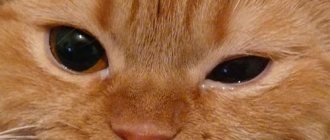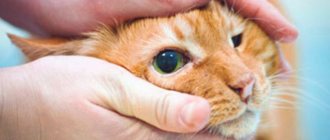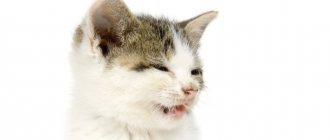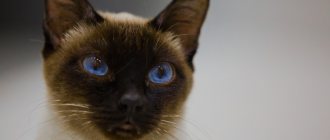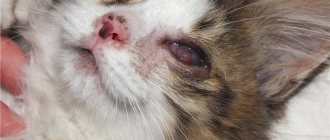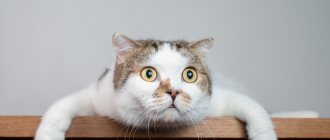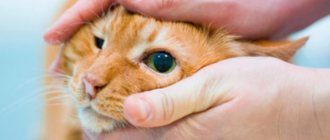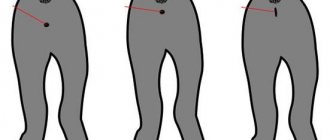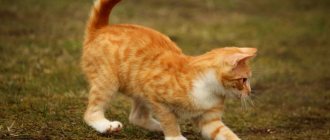The owner must carefully look after the pet, and if the cat’s one eye is watering and she squints, then he must carefully examine the pet and realize what is the reason for a similar situation. We'll tell you why a cat's eye is watering and what can be done.
Eye diseases causing redness
The following diseases can contribute to the appearance of such a symptom:
- Blepharitis. The disease is accompanied by inflammation of the eyelid skin caused by bacteria or fungi. May occur due to an allergic reaction or injury. Blepharitis is accompanied by swelling and baldness of the eyelids, squinting, frequent blinking, itching, mucous or purulent discharge.
- Conjunctivitis. The disease is of viral or bacterial origin. In the latter case, the inflammatory process is characterized by an abrupt onset and rapid course. The clinical picture of viral conjunctivitis develops more slowly. In this case, purulent discharge does not always appear. Liquid mucus may be released from the conjunctival sac, which does not stick the eyelids together after sleep. This makes diagnosis very difficult. In the bacterial form of inflammation, thick purulent discharge sticks the eyelids together. The redness is mild.
- Glaucoma. The disease is characterized by an increase in intraocular pressure. It is diagnosed frequently. The sclera in cats turns red due to vasodilation. An enlarged pupil does not respond well to light. The cat tries to stay in dark rooms. The cornea and lens become cloudy, the eyeball enlarges. The appearance of red around the eyes of a cat is accompanied by swelling and incomplete closure of the eyelids. The animal experiences pain, orientation in space is disturbed, and the cat’s vision deteriorates.
- Entropion. The disease is characterized by inward turning of the eyelids. Eyelashes irritate the eye shell and injure it. Acute pain and lacrimation occur, the skin becomes red, the eye becomes red, and blepharospasm immediately appears - involuntary movement of the eyelids. If left untreated, the corneal tissue becomes inflamed.
- Entry of a foreign body. A grain of sand, wood shavings or splinter falls on the surface of the eyeball, injuring it. The animal's eyelids swell and turn red, the cat is in severe pain, and the pet does not allow its head to be touched.
- Uveitis. In the early stages, the symptoms of the disease are similar to those of conjunctivitis. The conjunctiva turns red, signs of irritation appear, and the pupil stops responding to light. Lacrimation is combined with the discharge of pus or mucus. A pink rim appears around the eyeball. White spots are found on the cornea, the color of the iris changes. The non-infectious form of the disease may be accompanied by allergic rhinitis.
Protrusion (loss) of the third eyelid gland
Symptoms:
— A red or pink formation appears in the inner corner of one or both eyes.
- Discharge is usually in the form of tears or mucus in small quantities.
Treatment:
1. Surgical, preference is given to repositioning the gland rather than removing it, since this gland accounts for 30 to 50% of the total amount of tears produced.
============================================================================================================================================================================================
Diagnosis of diseases
To identify diseases accompanied by irritation and redness of a cat’s eyes, an examination is used, including:
- Assessment of visual functions. Helps determine whether an animal’s vision is impaired or not.
- Appearance assessment. At this stage, signs of the disease are revealed - changes in the size and shape of the pupil, reduction of the palpebral fissure, redness and inflammation of the eyelids, traumatic changes.
- Identification of signs of damage to the eyeball. The size, shape, and presence of foreign bodies on the surface of the sclera are determined.
Conjunctivitis
This is an inflammation of the outer layer of the eye, which is normally pink in color.
Symptoms:
- Redness of the eye,
— Discharge (can be transparent in the form of a tear, mucous, purulent)
- Squinting of the eye, local itching.
Treatment:
1. Use of local and systemic antibiotics and antiviral, and, if necessary, local antiallergic drugs.
============================================================================================================================================================================================
Treatment for red eyes in cats
For the treatment of eye diseases in cats, the following is used:
- Antiseptic solutions. If the animal's eyes are watery or purulent, they are washed with Furacilin solution. 1 tablet is dissolved in 200 ml of boiled water. A cotton swab is moistened with the liquid and used to wipe the eyes. The drug can be replaced with a light pink solution of potassium permanganate.
- Local antibiotics. Levomycetin or Gentamicin is instilled after primary treatment. The recommended single dose for an adult cat is 1 drop. Albucid is not recommended for use in treating animals; the drug causes a burning sensation. After administering the drops, the cat is held in your arms, which helps to avoid licking the medicine. Drops can be replaced with tetracycline, erythromycin or neomycin ointment.
- Healing agents. A small amount of Solcoseryl gel is placed behind the eyelid 2 times a day. The drug helps cope with irritation and the consequences of injuries.
- Systemic antibiotics. Cefazolin is used for eye diseases. The contents of the bottle are dissolved in 5 ml of novocaine. The drug is administered intramuscularly, the dosage depends on the weight and age of the animal.
- Antihistamines (Suprastin). Injections are given when allergic reactions to antibiotics occur.
- Folk remedies. A decoction of chamomile, oak bark or sage can be used for red eyes in kittens. 1 tbsp. l. Boil the herbs in 200 ml of water for 10 minutes. The product is cooled, filtered and used to treat the eyes 3-4 times a day.
In severe cases of the disease, surgical intervention is performed.
Precautionary measures
When treating cat eyes, precautions must be taken. Hands are washed with soap and water before and after the procedure. Do not eat or drink while working with medications.
If drops get on your skin, it is recommended to wash them off with running water as soon as possible. The cat is carefully restrained throughout the procedure, as it can escape and seriously injure the person holding it.
Eye drops are popular medications among cat owners. They are used both for treatment and for regular cleansing of the cat's eyes. Some medications can help cope with corneal dryness, which often affects flat-faced pets (Persians, exotics, etc.).
Prevention of eye diseases
Prevention of eye diseases in cats includes:
- Regular cleansing of the visual organs from natural secretions. Mucus that accumulates in the corners of the eyes becomes a good breeding ground for bacteria, which causes infectious conjunctivitis to develop.
- Avoid getting hair in the eyes. This problem affects long-haired animals. The hairs irritate the white of the eye, leaving scratches.
- Treatment of tear ducts. The area along the cat's nose is wiped with a cotton swab. This prevents the tear fluid from drying out.
- Proper implementation of hygiene procedures. When bathing an animal, do not allow detergents to get into the eyes. This also applies to insecticidal solutions used to treat cats against skin parasites at home. The products cause burns that contribute to redness of the eyes.
- Timely administration of vaccinations. Vaccination protects the animal from infections that cause eye diseases.
- Treatment of helminthic infestations. Parasitic worms produce toxins that can provoke negative reactions of the immune system, including allergic conjunctivitis.
The cat should be shown to the veterinarian at least once every six months.
All information posted on the site is provided in accordance with the User Agreement and is not a direct instruction to action. We strongly recommend that before using any product, you must obtain a face-to-face consultation at an accredited veterinary clinic.
Obstruction of the nasolacrimal duct
Normally, tears should flow out through a special channel that runs inside the nose (nasolacrimal duct), but if this outflow path is disrupted, the tear has nowhere else to flow except outward, to the area near the eyes.
Symptoms:
- Various degrees of lacrimation and brown coloration of the fur around the eyes (formation of “tear tracks”).
This may be a breed predisposition - as congenital pathology is often found in Sphynx, Persian, British, exotic, Scottish and other short-faced cats; or as a consequence of inflammatory processes in the eye area.
Treatment:
1. If the obstruction is associated with overgrowth or blockage of the nasolacrimal duct, then surgical dilation of the canal is possible. 2. But most often, with this problem, it is enough to carry out daily hygienic care using special lotions to remove tear ducts.
===========================================================================================================================================================================================
Uveitis
Inflammation of the iris and ciliary body - structures located inside the eye.
Symptoms:
- Squinting, redness and clouding of the eye.
- Constriction of the pupil.
— Precipitates on the corneal endothelium (small white dots on the inner surface of the cornea)
— Exudate (effusion) in the anterior chamber of the eye
- Decrease in intraocular pressure.
Treatment:
1. Local corticosteroids, non-steroidal anti-inflammatory drugs, mydriatics and systemic drugs.
===========================================================================================================================================================================================
Natural causes of tearing
Sometimes a domestic cat's eye becomes swollen for a short time, does not open, and waters. This is quite a normal situation after sleep. It is enough to rinse it with warm brewed black tea or running water. Abundant transparent tears often appear in purebred long-haired pets. Their tear ducts are irritated by their long fur. To prevent the animal from suffering, it must be periodically combed, the hair on its face trimmed, and the eyelids treated with special drops.
A little tearing is considered normal in Scottish, Persian and British cats. These breeds “cry” due to the anatomical features of the skull. They have shortened nasal and tear ducts. Watery eyes usually do not cause discomfort to your pet. All that is required from the owner is hygienic treatment and observation. If the cat’s eye is already swollen and very watery, pus has appeared - these are symptoms of an infectious process.
Establishing diagnosis
Before starting treatment, it is imperative to conduct a diagnosis that will help identify the true cause of excessive lacrimation and carry out effective treatment therapy. Only a veterinarian can conduct a correct and thorough examination.
Important! Before going to the veterinarian, be sure to prepare a pet card, which should indicate all vaccinations, anthelmintic treatments, and past illnesses. It is advisable to write down symptoms of malaise and other suspicious signs on a piece of paper.
Sometimes the veterinarian may be interested in the following important questions at the appointment:
- how long the symptoms last;
- how did the first symptoms of tearing from the eyes appear and the peculiarities of the course of this condition, for example, did two eyes immediately begin to water at the same time, or vice versa, first one began, and then the other, and whether there are other additional symptoms;
- when the last procedures to eliminate helminths, fleas, ticks and other parasites were carried out.
To make an accurate diagnosis, the veterinarian will definitely take a urine and stool test. It is advisable to already have the research material with you before going to the doctor. Also, at the appointment, he will definitely take mucus from the eye for examination; for this reason, there is no need to first rinse the pet’s eyes with various solutions.
